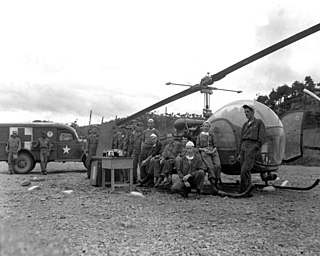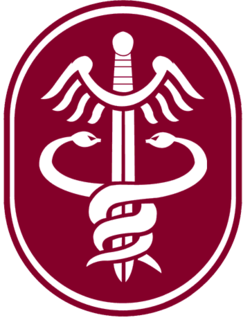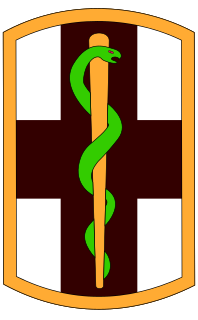
Battlefield medicine, also called field surgery and later combat casualty care, is the treatment of wounded combatants and non-combatants in or near an area of combat. Civilian medicine has been greatly advanced by procedures that were first developed to treat the wounds inflicted during combat. With the advent of advanced procedures and medical technology, even polytrauma can be survivable in modern wars. Battlefield medicine is a category of military medicine.

Mobile Army Surgical Hospitals were conceptualized in 1946 as revolutionized units of ASG Units which were “Auxiliary Surgical Hospitals” made during World War II became obsolete. MASH units had 60 beds, surgical, nursing, other enlisted and officer staff available at all times. Often working long hours to save lives in many wars, MASH Units were in operation from the Korean War all the way to the Gulf War and the remnants slowly disappeared in the early 2000s. MASH units filled a very vital role in military medicine, that was providing close support to army units upwards of 10,000 to 20,000 soldiers. There is also a low mortality rate as a whole coming from these units as the transportation time to hospitals was low resulting in fewer patients dying within the “Golden Hour”. The “Golden Hour” is the first hour after an injury to a person which is referred to in drama as the most important hour. This is because mobility and mortality have the highest chances of being kept for a patient, that is one of the reasons why MASH units were located so close to the front lines. The term was made famous in the novel, movie, and television series M*A*S*H, which depicted a fictional MASH unit. The U.S. Army deactivated the last MASH unit on February 16, 2006. The successor to the Mobile Army Surgical Hospital is the Combat Support Hospital.

The U.S. Army Medical Command (MEDCOM) is a direct reporting unit of the U.S. Army that formerly provided command and control of the Army's fixed-facility medical, dental, and veterinary treatment facilities, providing preventive care, medical research and development and training institutions. On 1 October 2019, operational and administrative control of all military and veteran medical facilities transitioned to the Defense Health Agency.

A combat support hospital is a type of modern United States Army field hospital. The CSH is transportable by aircraft and trucks and is normally delivered to the Corps Support Area in standard military-owned demountable containers (MILVAN) cargo containers. Once transported, it is assembled by the staff into a tent hospital to treat patients. Depending upon the operational environment, a CSH might also treat civilians and wounded enemy soldiers. The CSH is the successor to the mobile army surgical hospital.

USNS Comfort (T-AH-20) is a Mercy-class hospital ship of the United States Navy.

Casualty evacuation, also known as CASEVAC or by the callsign Dustoff or colloquially Dust Off, is a military term for the emergency patient evacuation of casualties from a combat zone. Casevac can be done by both ground and air. "DUSTOFF" is the callsign specific to U.S. Army Air Ambulance units. CASEVACs by air today are almost exclusively done by helicopter, a practice begun on a small scale toward the end of World War II; before that, STOL aircraft, such as the Fieseler Fi 156 or Piper J-3 were used.

A field hospital is a temporary hospital or mobile medical unit that takes care of casualties on-site before they can be safely transported to more permanent facilities. This term was initially used in military medicine, but it is inherited to be used in disasters and other emergency situations.

The David Grant USAF Medical Center (DGMC) at Travis Air Force Base in Fairfield, California, is the U.S. Air Force’s largest medical center in the continental United States and serves military beneficiaries throughout eight western states. It is a fully accredited hospital with a National Quality Approval gold seal by the Joint Commission, and serves more than 500,000 Department of Defense and Department of Veterans Affairs Northern California Health Care System eligible beneficiaries in the immediate San Francisco-Sacramento vicinity from 17 counties covering 40,000 square miles. DGMC is named in honor of Dr. David Norvell Walker Grant, USAAF, MC (1891-1964), the first Surgeon General of the U.S. Army Air Corps and U.S. Army Air Forces.

A disaster medical assistance team (DMAT) is a group of professional medical personnel organized to provide rapid-response medical care or casualty decontamination during a terrorist attack, natural disaster, or other incident in the United States.

The National Disaster Medical System (NDMS) is a federally coordinated healthcare system and partnership of the United States Departments of Health and Human Services (HHS), Homeland Security (DHS), Defense (DOD), and Veterans Affairs (VA). The purpose of the NDMS is to support State, local, Tribal and Territorial authorities following disasters and emergencies by supplementing health and medical systems and response capabilities. NDMS would also support the military and the Department of Veterans Affairs health care systems in caring for combat casualties, should requirements exceed their capacity.
The role of the Commando Logistic Regiment (CLR), Royal Marines is to provide second line Combat Service Support to 3 Commando Brigade.

R Adams Cowley Shock Trauma Center is a free-standing trauma hospital in Baltimore, Maryland and is part of the University of Maryland Medical Center. It was the first facility in the world to treat shock. Shock Trauma was founded by R Adams Cowley, considered the father and major innovator of trauma medicine.

The 59th Medical Wing (MDW) is the U.S. Air Force's largest medical wing and is the Air Force functional medical command for Joint Base San Antonio (JBSA). It comprises seven medical groups across San Antonio. Three are located at the Wilford Hall Ambulatory Surgical Center (WHASC); the 959th Medical Group is located at San Antonio Military Medical Center (SAMMC), JBSA-Fort Sam Houston; the 59th Training Group - the wing's newest group, activated on 4 January 2016, is also located at JBSA-Fort Sam Houston. The 359th and 559th Medical Groups are located at and support the missions of JBSA-Randolph and JBSA-Lackland, respectively.
The 1st Close Health Battalion (1CHB) was a unit of the 17th Sustainment Brigade of the Australian Army. It headquartered at the Robertson Army Barracks in Darwin, but had sub-units located in Darwin, Townsville and Brisbane. The unit traced its lineage back to the 1st Field Hospital, which was raised in the 1960s for service as part of Australia's contribution to the Vietnam War. Since then, the unit has changed names twice and personnel have been deployed on numerous peacekeeping and warlike operations throughout Africa, the Middle East and the Asia-Pacific region. The 1st Close Health Battalion disbanded in December 2021 however lives on through the ‘’’1st Health Battalion (1HB)’’’ who have retained the bat symbol. It’s companies have now become their own Battalions excluding 8CHC who was absorbed into 1HB. 8CHC is now 1HB, 11CHC is now 2HB, 8CHC/7PL is now 3HB and 2CHC is now 4HB.

Virtua is a non-profit healthcare system in southern New Jersey that operates a network of hospitals, surgery centers, physician practices, and more. Virtua is South Jersey's largest health care provider. The main headquarters are located in Marlton.

The 28th Combat Support Hospital was a Combat Support Hospital of the United States Army. It was first constituted in 1943 and served in China during World War II. During the Gulf War in 1990, it was the first Army hospital unit established and deployed into Iraq with combat forces of the XVIII Airborne Corps. More recently it has been involved in relief operations following natural disasters and has undertaken several recent deployments to Iraq. The unit fell under the command of the 44th Medical Brigade and was based at Fort Bragg, North Carolina.

The 10th Field Hospital is a Field Hospital of the United States Army first constituted on 23 June 1942 in the Army of the United States as the 10th Field Hospital.

The 274th Forward Surgical Team (Airborne)—part of the 274th Forward Resuscitative and Surgical Detachment (Airborne)—is an airborne forward surgical team of the United States Army providing Level II care far forward on the battlefield. It was first constituted in 1944 and served in Europe during World War II. More recently it has been involved in relief operations following natural disasters and has undertaken several recent deployments to Iraq and Afghanistan. The 274th Forward Surgical Team was part of both the initial entry forces of Operation Enduring Freedom in 2001 and Operation Iraqi Freedom in 2003. Currently the unit falls under the command of the 28th Combat Support Hospital and is based at Fort Bragg, North Carolina.

The 1st Medical Brigade is a medical brigade of the United States Army. It is located at Fort Hood, Texas, providing health care and medical services to the Fort Hood community, and continuing training in its combat support mission.
335 Medical Evacuation Regiment is a British Army medical regiment and part of 2 Medical Brigade. It is an Army Reserve unit, part of the Royal Army Medical Corps, and has a unique role within the Armed Forces. The Regiment is paired with all three of the armoured medical regiments within the Reactive Force: 1 Armoured Medical Regiment, 4 Armoured Medical Regiment and 5 Armoured Medical Regiment. Although it is administered from Queen Elizabeth Barracks in North Yorkshire, as a specialist unit the regiment recruits reservists from all over the UK.
















